Join More Than 50,000+ Subscribers and get latest camera news and rumors
NEW CAMERA VIDEOS ON YOUTUBE
|
By admin, on April 15th, 2025

Nikon Z5 II vs Sony A7 III – Let’s compare the two and find out the best, we have selected all the major difference between the two camera, starting from the desing part, and the the Major differences in the photography part of both camera,s and finally, the best camera for video.
In the Latest Nikon Z5 II, we have a deep rear hand grip and an enhanced display as well as an electronic viewfinder. The rear display screen in the Nikon Z5 II is a vari-angle display screen with higher resolution, so you can also create content/vlog with the camera, and photographers will have a bit more compositional freedom. The electronic viewfinder is of higher resolution and rated up to 3000 nits of brightness, helping to shoot perfectly in daylight conditions. The Nikon Z5 II design is slightly more professional and looks very similar to the Nikon professional Z6 III model. The battery life of the Nikon Z5 II is slightly limited so you have to carry an extra battery pack or a power bank with you.
| Aspect |
Nikon Z5 II |
Sony A7 III |
| Body Dimensions |
134 x 100.5 x 72 mm (Large handgrip) |
127 x 96 x 74 mm (Slightly small) |
| Weight |
700g (with battery, media) |
650g (with battery) |
| Grip & Ergonomics |
Larger, deeper grip with still/video switch, tactile dials |
Smaller grip, more custom buttons, compact layout |
| Build & Weather Sealing |
Magnesium alloy, weather-sealed (32 to 104°F, 85% humidity) |
Magnesium alloy, dust/moisture resistant (tropicalization) |
| Card Slots |
Dual UHS-II SD/SDHC/SDXC slots |
One UHS-II + one UHS-I SD slot |
| Display Size |
3.2-inch touchscreen |
3.0-inch touchscreen |
| Display Resolution |
2,100,000 dots |
921,600 dots |
| Display Type |
3-way tilting (up/down/side) vari-angle |
2-way tilting (up/down) |
| Touchscreen Functionality |
Full control (menus, focus, zoom) |
Limited (focus point, double-tap zoom) |
| Viewfinder Type |
Electronic OLED |
Electronic OLED |
| Viewfinder Resolution |
3,690,000 dots |
2,359,296 dots |
| Viewfinder Magnification |
0.8x |
0.78x |
| Viewfinder Eye Point |
21 mm |
23 mm |
| Battery |
1x EN-EL15c Lithium-Ion (~380 shots CIPA) |
1x NP-FZ100 Lithium-Ion (~610 shots CIPA) |
| Power Delivery |
USB-C input/output (live power during shooting) |
USB 3.1 (charging only) |
| Video I/O |
Micro-HDMI output |
Mini-HDMI output |
| Audio I/O |
3.5mm headphone, 3.5mm microphone |
3.5mm headphone, 3.5mm microphone |
| Other I/O |
3.5mm remote, USB-C 3.2/3.1 Gen 1 (data/power) and Multi-interface shoe |
Multi-interface shoe (remote/audio), USB 3.1 (data) |
| Wireless Connectivity |
2.4/5 GHz Wi-Fi 5 (802.11ac), Bluetooth 5.0 |
2.4 GHz Wi-Fi (802.11b/g/n), Bluetooth 4.1 |
| NFC |
None |
Included |
| Mobile App |
SnapBridge (Android/iOS, files/firmware/remote) |
Imaging Edge Mobile (Android/iOS, files/remote) |
| GPS |
Via smartphone (SnapBridge) |
Via smartphone (Imaging Edge) |

Internal Core specification of the camera
Both cameras use a 24-megapixel full-frame BSI CMOS sensor, but the Nikon Z5 II, with the help of new image processor features, has a standard ISO range of up to 64000 and expandable up to 204800, which is one stop more than that of the Sony A7 III.
Not only does it have a better ISO range, but the new Z5 II camera also uses a sensor-shift image stabilisation system of 7.5 stops. As we know, the A7 III is limited to 5 stops, so Z5 II will be helping you a bit more to capture low-light images while hand-holding this camera.
Adding more value to it, the autofocus sensitivity now can touch down to minus 10 EV, and in Sony, it is limited to minus 3. So, we consider all these factors — the Z5 II becomes a bit more suitable a camera to work with under variable light conditions.
Nikon Z5 II vs Sony A7 III – Photography Core Specs Comparison
| Aspect |
Nikon Z5 II |
Sony A7 III |
| Sensor Type |
24.5MP full-frame CMOS (6048 x 4032) |
24.2MP full-frame BSI CMOS |
| Sensor Crop |
1.0x (full-frame) |
1.0x (full-frame) |
| Image Stabilization |
5-axis sensor-shift IBIS(7.5 Stops CIPA) |
5-axis sensor-shift IBIS (5.0 stops CIPA) |
| ISO Sensitivity (Photo) |
100-64,000 (Extended: 50-204,800) |
100-51,200 (Extended: 50-102,400) |
| Autofocus Points |
273 phase-detection points |
693 phase-detection + 425 contrast points (93% coverage) |
| AI AF Type |
9 Different types of subject tracking include Bird eye AF |
Precise and better, but doesn’t have a dedicated bird eye AF mode |
| Autofocus Sensitivity |
-10 to +19 EV |
-3 to +20 EV |
| AF Modes |
Continuous-Servo, Full-Time Servo, Manual, Single-Servo |
Continuous, Manual, Single, Tracking |
| Specialized AF |
Bird/insect/vehicle + 9-subject AI detection |
Real-time Eye AF (human/animal) |
| Continuous Shooting |
14 FPS + 30 fps (Mech + electronic shutter) |
10 fps (mechanical/electronic) |
| Buffer Depth |
200 RAW frames @ 14 FPS |
~89 RAW at 10 fps |
| Shutter Type |
Mechanical focal plane + electronic rolling |
Mechanical + electronic front-curtain |
| Shutter Speed |
1/8000 to 30 sec, Bulb/Time modes |
1/8000 to 30 sec, Bulb mode |
| Metering Methods |
Center-Weighted, Highlight Weighted, Matrix, Spot |
Center-Weighted, Multi-zone, Spot |
| Metering Range |
-4 to 17 EV |
-3 to 20 EV |
| Exposure Modes |
Aperture Priority, Auto, Manual, Program, Shutter Priority |
Aperture Priority, Auto, Manual, Program, Shutter Priority |
| Exposure Compensation |
-5 to +5 EV (1/3, 1/2 EV steps) |
-5 to +5 EV (1/3, 1/2 EV steps) |
| White Balance |
Auto, Cloudy, Color Temp, Sunlight, Flash, Fluorescent, Incandescent, Manual, Shade |
Auto, Cloudy, Color Temp, Custom, Daylight, Flash, Fluorescent, Incandescent, Shade, Underwater |
| Image File Formats |
HEIF, JPEG, RAW (14-bit) |
JPEG, RAW (14-bit) |
| Aspect Ratios |
1:1, 3:2, 16:9 |
3:2, 16:9 |
| Interval Recording |
Yes |
No |
| Self-Timer |
2/5/10/20 sec delay |
2/5/10 sec delay |
| Flash Sync Speed |
1/200 sec |
1/250 sec |
| Flash Compensation |
-3 to +1 EV (1/3, 1/2 EV steps) |
-3 to +3 EV (1/3, 1/2 EV steps) |

Autofocusing mode
The new Z5 II features the same AI AF algorithm that we have seen in the Nikon Z8 camera and uses 9 different types of subject detection algorithms. While shooting a scene, it automatically detects a subject, focuses on their eye, and keeps tracking them.
So overall, the autofocusing experience of the Nikon Z5 II camera has been upskilled like a professional Nikon mirrorless camera.
The Sony A7 III does have a very strong eye autofocus and tracking mechanism, but it does lack a multiple subject detection mode or AI AF in it since it’s a 2018 model. Expecting too much from it isn’t good. Although it has a higher number of autofocus points, it does focus very well.
Continuous shooting speed:
The Nikon Z5 II camera is now able to capture 14 frames of RAW with the help of a mechanical shutter and up to 30 frames of full-size JPEG images. The camera also supports a pre-capture function, highly suitable for sports and wildlife shooters, that stores 30 30-FPS bursts before you press the shutter.
And the good thing is that the Nikon Z5 II refreshes its AI autofocus and auto exposure in every single frame, even if you are using it at 30 per second.
The Nikon Z5 II is also a highly reliable camera, but it remains limited to 11 frames per second. The Z5 II now becomes a perfect option for sports or wildlife photographers, anyone who loves to capture as many frames as possible of their favourite moment.
Nikon Z5 II vs Sony A7 III -Video Core Specs Comparison
| Aspect |
Nikon Z5 II |
Sony A7 III |
| Internal Recording Modes |
4K (3840 x 2160) at 23.98/25/29.97/50/59.94 fps; 1080p at 23.98/25/29.97/50/59.94/100/120 fps |
4K (3840 x 2160) at 23.98/25/29.97 fps; 1080p at 23.98/25/29.97/50/59.94/120 fps |
| Sensor Crop (4K) |
DX crop at 4k 60p |
NA |
| Internal Recording |
12-bit NRAW Video, 4:2:2 10-bit internal recording, 4K up to 29.97 fps |
8-bit via HDMI, 4K up to 29.97 fps |
| Video Profiles |
H.265, H.264/MOV/MP4 (N Log ) |
H.264, S-Log2/3, HLG |
| Recording Limit |
2 hr 5 min |
~29 min (pre-firmware) |
| Audio Recording |
24-bit 48 kHz (MOV/RAW), 16-bit 48 kHz (MP4) |
16-bit 48 kHz |
| Built-In Microphone |
Stereo |
Stereo |
| Fast/Slow-Motion Support |
None (1080p/120 fps max) |
None (1080p/120 fps max) |
| Streaming |
Yes / Upto 4K |
None |
Video comparison
In video, it’s very clearly visible in the table also that the Sony A7 III camera remains limited to 8-bit internal recording and even it has a time limitation of 30 minutes, whereas in the Nikon Z5 II camera we can record 4:2:2 10-bit internal recording at the rate of 4K 60 frames per second. But while recording at 60 FPS, we have to face DX crop, and when we are recording 4K 30 FPS, we are getting high-quality oversampled footage from the sensor.
Not limited to that, with higher quality video recording capability, you also get more stable footage due to the new 7.5 stops of IBIS mechanism, as well as integrated EIS compared to 4.5 to 5 stops of IBIS of the Sony A7 III.
Conclusions
Overall, for wedding cinematographers, content creators or professional cinematographers, the Nikon Z5 II is more usable in terms of specs when compared to the Sony A7 III.
Now, considering all these major factors, for sure, for a photographer, the Nikon Z5 II camera is now more suitable to use in comparison to the Sony A7 III camera. If Sony wants to beat the Z5 II. Sony needs to bring a perfect replacement for the A7 III camera. Either they should bring out the A7 IIIA or they should lower the price of A7 IV to an extent that users can buy it instead of the Nikon Z5 II.
Nikon Z5 II vs Nikon Z6 II | Nikon Z5 II vs Canon R8 | Nikon Z5 II vs Nikon Zf | Nikon Z5 II vs Sony A7 III
Get the Nikon Z5 II camera from B&H Store | Adorama.com | Amazon.com
Support us – Use or affiliate link Amazon.com | B&H Store | Adorama.com for the next purchase u make – it helps us 🙂
Follow us on our social pages FACEBOOK | TWITTER | INSTAGRAM to get live Camera News + Nikon Rumors 24X7
By admin, on February 26th, 2025
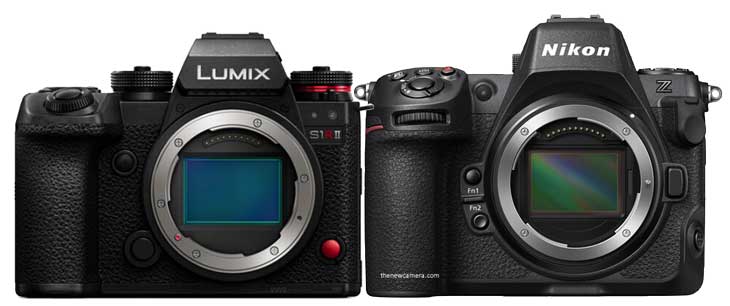
Panasonic S1R Mark II – Best for Landscape & Fine Art Photography
Let’s directly jump to the recommendations. Panasonic S1R Mark II camera is recommended for landscape and fine art shooters, and its specifications in indoor architecture suit well. The big reason is the higher resolution sensor and the ability to record higher resolution handheld modes, allowing you to generate 150+ megapixel images in a single handheld shot.
Buy and help us to visit the barista again Nikon Z8 B&H Store
Professional Cinematography & Open-Gate Recording
Now, the big thing is that if you are a professional cinematographer or videographer, then the Panasonic S1R Mark II camera may fit your needs more perfectly since, for professionals, we do have an option to record videos in open-gate format. Right now, with the basic settings, you are getting open-gate at 5.8K, but soon after a series of firmware updates, open-gate recording will become available up to 8K 30fps.
Why Panasonic S1R Mark II for Professional Cinematographers?
So why are we recommending the Panasonic S1R Mark II camera for professional cinematographers? Since we are getting wavefront functionality, we are also getting anamorphic lens recording support, so you can de-squeeze your footages in-camera, as well as options like false color, which helps you judge the level of accuracy in color tones while shooting.
Another important feature is the shutter angle, and the list doesn’t end here. You also get an option to directly record your videos on an SSD drive, so there’s no big issue regarding memory cards—you can simply replace your SSD when it’s full.
Panasonic S1R Mark II – Autofocus System & Its Limitations
The hybrid autofocus system is still in its development stage. The autofocus is reliable but requires expertise to handle the Panasonic AF system correctly. Otherwise, even people operating cameras for more than three years may struggle with it. The reason is very simple: it’s not a turn-and-go AF system.
So, when we talk about the best hybrid autofocus system between these two cameras, without a doubt, the Nikon Z8 is the best. We are not saying that the S1R Mark II is not usable—it is usable—but the precision, fastness, and readout speed due to the presence of stacked sensors, refresh rate, and subject detection, most of which are directly inherited from the Nikon Z9, make the Nikon Z8 a perfect camera for sports and wildlife photography.
Also, keep in mind that the autofocus tracking of the Panasonic S1R Mark II camera remains limited to 10 frames per second. So that’s the limit you get with the S1R Mark II, whereas there is no such limit in the Nikon Z8. The eye-tracking remains active even at 120 frames per second, and it works exceptionally well while using 30fps and 40fps modes of the Z8 at full resolution. The eye-tracking AF and exposure remain fully active.
Another thing to consider: The lens ecosystem
Now, you have to understand the lens ecosystem. The Z mount has been opened up, and we have a range of lens options available inside the Nikon system. That doesn’t mean the L-mount is lacking—L-mount also has a huge range of lenses—but Tamron is still not a part of the L-mount system. If you are a wedding photographer looking for a budget high-quality constant aperture lens, Nikon has options like the Tamron 28-75mm G2 lens for the Z8. At this price point, no equivalent L-mount lenses are available for the S1R Mark II. You have to pay extra to get an f/2.8 constant aperture zoom lens in the L-mount system.
So, should a wedding photographer buy the Panasonic S1R Mark II or the Nikon Z8?
If you are inclined toward the Panasonic S1R Mark II camera, you can buy it—it’s a good-to-go camera. But if we compare all the features offered by both cameras, the Nikon Z8 looks a bit more suitable with its faster stacked CMOS sensor, highly responsive hybrid autofocus system, and the huge range of Z-mount lenses available, especially budget-friendly high-quality lenses like the Tamron 28-75mm f/2.8 G2. All these factors make the Nikon Z8 a more feasible and recommendable camera for wedding photographers.
Autofocus Tracking & Frame Rate Comparison
- Panasonic S1R Mark II is limited to 10fps AF tracking.
- Nikon Z8 has no such limit—eye-tracking remains active even at 120fps.
- Works exceptionally well at 30fps and 40fps while maintaining full eye-tracking AF and exposure.
Lens Ecosystem – Nikon Z8 vs. Panasonic S1R Mark II
Now, you have to understand the lens ecosystem:
- Z mount is open—a wide range of lens options available inside Nikon’s system.
- L-mount also has a huge range of lenses, but Tamron is still not part of the L-mount system.
- Wedding photographers looking for budget high-quality f/2.8 lenses have Tamron 28-75mm G2 for the Nikon Z8.
- No equivalent budget-friendly f/2.8 zoom lens for L-mount—you have to pay extra for a constant aperture zoom lens.
A little more about the Nikon Z8 camera
The Nikon Z8 features a stacked CMOS sensor directly inherited from the Nikon Z9. Even the autofocus algorithm and image processor are exactly the same, making it essentially a flagship camera inside a compact Z8 body.
If you are interested in wildlife and sports photography and want rolling shutter-free images, the Nikon Z8 stands out despite the fact that many photographers still use conventional sensors. If you plan to shoot at higher frame rates with the Panasonic S1R Mark II at 30 or 40 frames per second, it’s a well-known fact that Panasonic struggles to track subjects continuously at high frame rates.
At the same time, the Nikon Z8’s sensor image stabilization system works at the pixel level with the help of AI advancements. If you consider all these factors, then the Nikon Z8 is without a doubt recommended for photographers looking for a perfect hybrid camera—especially those interested in wildlife and sports photography.
Final Verdict: Panasonic S1R Mark II vs. Nikon Z8
Who Should Buy the Panasonic S1R Mark II?
✅ Best for Landscape & Fine Art Photography – The high-resolution sensor and 150+ megapixel handheld mode make it ideal for professionals focused on fine details and large-format prints.
✅ Great for Cinematographers & Videographers – Open-gate recording (5.8K, up to 8K with updates), anamorphic lens support, false color monitoring, and SSD recording support make it a solid choice for high-end video production.
❌ Not the Best for Fast-Paced Shooting – The autofocus system is still in development, requiring expertise to operate correctly, and AF tracking is limited to 10 fps, making it less suitable for sports and wildlife photography.
❌ Limited Lens Ecosystem & Expensive Lenses – While L-mount has a good selection of lenses, Tamron, Viltrox, and many new third-party lens makers are not part of the system or have very few lenses for L Mount, making affordable fast lenses harder to find.
Who Should Buy the Nikon Z8?
✅ Best for Sports & Wildlife Photography – Stacked CMOS sensor (inherited from the Z9) enables fast readout, high-speed shooting, and advanced subject tracking. AF tracking remains active up to 120 fps, making it superior for action shots.
✅ Stronger Hybrid Autofocus System – Fast, precise, and reliable autofocus, with advanced AI-driven subject detection and Z9-level AF algorithms, makes it easier to use and more responsive.
✅ Expansive & Budget-Friendly Lens Ecosystem – The Z-mount system has a wide range of native lenses, including affordable high-quality options like the Tamron 28-75mm f/2.8 G2.
✅ Great for Hybrid Shooters (Photo & Video) – While it lacks open-gate recording, the stacked sensor, superior autofocus, and high-speed burst shooting make it a more versatile camera for both photo and video work.
Final Recommendation
- If you are a landscape, fine art, or professional cinematographer, the Panasonic S1R Mark II is a strong contender due to its high-resolution capabilities and pro-video features.
- If you shoot sports, wildlife, weddings, or need the best hybrid performance, the Nikon Z8 is the clear winner, thanks to its superior autofocus, faster shooting speeds, and larger lens ecosystem.
For most photographers and hybrid shooters, the Nikon Z8 offers a more balanced and versatile package. However, if high-resolution stills or advanced video tools like open-gate recording are your priority, the Panasonic S1R Mark II is the better choice.
Get the Panasonic S1R Mark II Camera from Adorama.com | B&H Store | Amazon.com
Panasonic S1R II vs Nikon Z8 – Specification comparison table
| Category |
Panasonice Lumix S1R II |
Nikon Z8 |
| – Sensor Type |
Full-frame BSI CMOS |
Full-frame stacked CMOS |
| – Resolution |
44.3 MP |
45.7 MP |
| – ISO Range |
40-102400 |
64-25600 (expandable to 32-102400) |
| – Color Depth |
14-bit |
14-bit |
| Autofocus System |
|
|
| – Type |
Phase + Contrast detection with DFD, AI-based |
493-point phase-detect AF / Faster AF Refresh rate due to the stacked sensor |
| – AF Points |
Not specified, but improved over previous models |
493 points (covers 90% of frame) |
| – Speed and Accuracy |
Fast, with AI tracking for subjects |
Fast and accurate, -7EV to EV19 sensitivity, -9EV with starlight view |
| – Subject Tracking |
AI-based for faces, eyes, animals |
Specific modes for birds, animals, vehicles, etc. |
| Video Capabilities |
|
|
| – Max Resolution and Frame Rates |
8K at 30fps, 4K at 120fps |
8K at 60fps (N-RAW), 4K at 120fps |
| Open Gate Recording |
5.8k Opengate (8K soon to be available via Firmware) |
None |
| – Formats |
H.265 10-bit 4:2:0 for 8K, ProRes 422 for lower resolutions |
N-RAW, ProRes RAW, H.265, H.264, 10-bit color |
| – Stabilization |
In-body image stabilization 8 Stops |
Pixel Level Accuracy – AI IBIS with Full sensor 8 Stops IBIS rating |
| Shutter angle |
Yes |
Yes |
| False Color |
yes |
No |
| – Audio |
Built-in stereo mic, external mic jack |
Built-in stereo mic, microphone, and headphone jacks |
| Waveform |
Yes |
Yes |
| Recording to SSD |
Yes |
No |
| Anamorphic |
Yes, it Supports Desqueez in the camera |
No |
| Shooting Speed and Performance |
|
|
| – Continuous Shooting Speed |
Up to 40 fps, but Active tracking works up to 10 fps |
Up to 120 fps (with crop), 30 fps full-res | 30 Fps full tracking |
| – Buffer Capacity |
Large, can shoot extended bursts |
Large, can handle extended bursts |
| – Shutter Speed Range |
1/8000 to 60s (assumed, typical for mirrorless) |
1/32000 to 900s (electronic), 1/8000 to 30s (mechanical) |
| Display and Viewfinder |
|
|
| – Viewfinder |
OLED EVF, 5.69m dots (assumed, similar to S5 II) |
3.69m-dot OLED EVF |
| – LCD Screen |
3.2-inch, 2.1m dots, articulated (assumed, similar to original S1R) |
3.2-inch tilting touchscreen, 2.36m dots |
| – Touchscreen |
Yes |
Yes |
| Connectivity and Wireless Features |
Wi-Fi, Bluetooth, smartphone app |
Wi-Fi, Bluetooth, Nikon SnapBridge app |
| Battery Life and Power |
|
|
| – Battery Type |
BLK-22 (same as S5 II) |
EN-EL15c |
| – Life |
~370 shots (assumed, similar to S5 II) |
~300-400 shots |
| – External Power |
USB-C |
USB-C |
| Physical Design and Ergonomic Features |
|
|
| – Size |
Smaller and lighter than the original S1R (over 200g lighter) |
Smaller than Z9, comparable to D850 |
| – Weight |
~800g |
910g |
| – Weather Sealing |
Yes |
Yes |
| – Ergonomic Features |
Classic DSLR-style shape, various dials and buttons |
Nikon-style layout, various controls |
| Lens Mount and Compatibility |
|
|
| – Mount |
Leica L-mount |
Nikon Z-mount |
| – Available Lenses |
Wide range from Leica, Sigma, etc. |
Wide selection of Nikon Z lenses |
Which One to Choose?
- For landscape, fine art, and professional cinematographers → Panasonic S1R Mark II (due to high-resolution mode & video tools).
- For sports, wildlife, and hybrid photography → Nikon Z8 (due to superior AF, stacked sensor, and high-speed tracking).
- For wedding photographers → Nikon Z8 (better autofocus, lens options, and hybrid usability).
UPDATE Feb 27 – Nikon added Shutter angle and Waveform Monitor in Nikon Z6 III and Nikon Z8
By admin, on January 18th, 2025
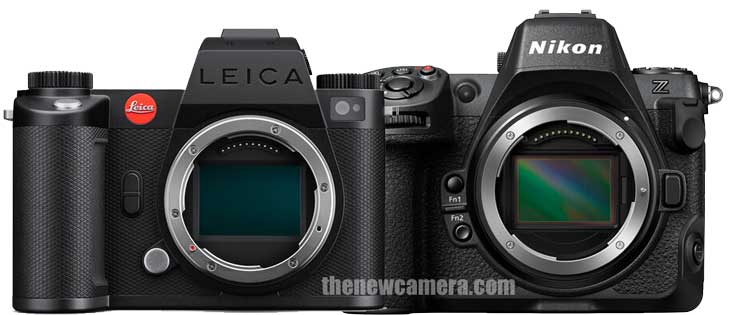
Nikon Z8 versus Leica SL-3 S: Which is the Best Camera Among These Two? If you are planning to buy the Leica SL3 S camera, you must first look at the Z8 core specification comparison table before making a decision.
Design Comparison
| Feature |
Nikon Z8 |
Leica SL3-S |
| Lens Mount |
Nikon Z |
L-Mount |
| Build Material |
Magnesium Alloy |
Aluminum, Magnesium Alloy |
| Dimensions (W x H x D) |
5.7 x 4.7 x 3.3″ (144 x 118.5 x 83 mm) |
Not Specified |
| Weight |
2.0 lb (910 g, with battery and recording media) |
4.715625 lb / 2139 g (With Battery)
1.7 lb / 768 g (Body Only) |
| Display Type |
3.2″ 4-Axis Tilting Touchscreen LCD, 2,100,000 dots |
3.2″ Tilting Touchscreen LCD, 2,332,800 dots |
| Viewfinder Type |
0.5″ OLED, 3,690,000 dots, Approx. 0.8x Magnification |
OLED, 5,760,000 dots, Approx. 0.76x Magnification |
| Eye Point |
23 mm |
21 mm |
| Weather Sealing |
Yes |
Yes |
| Wireless Connectivity |
Wi-Fi 5 (2.4 / 5 GHz), Bluetooth 5.0 |
2.4 GHz MIMO Wi-Fi, Bluetooth 5.0 |
| Dual Card Slots |
CFexpress Type B / XQD + SD (UHS-II) |
1x CFexpress Type B, 1x SD (UHS-II) |
| GPS |
Yes (via smartphone) |
Yes (via smartphone) |
Which camera is better for longer hours of work, like weddings and events lasting hours, the Leica SL3 S or Nikon Z8?
In the design comparison, it is visible that the Leica is built like a tank, heavier, but at the same time, the electronic viewfinder and the display part of the camera are of more premium quality. For more prolonged shooting, such as during weddings and events lasting over 7-8 hours or more, it’s recommended to hold a camera that makes you comfortable for longer hours of work, like the Nikon Z8.
Photography Comparison
| Feature |
Leica SL3-S |
Nikon Z8 |
| Sensor Resolution |
24.6 MP (Effective) |
45.7 MP (Effective) |
Sensor Tech
|
BSI CMOS |
STACKED BSI CMOS |
| Sensor Type |
Full-Frame |
Full-Frame |
| ISO Range |
100 to 200,000 (manual) |
64 to 25,600 (Extended: 32 to 102,400) |
| Continuous Shooting |
Up to 30 fps |
Up to 20 fps Raw, 30 fps JPEG Shooting |
Image Stabilization
|
Upto 5 – Stops (max) |
5.5 (Max 6 Stops with VR Lens) + AI IS |
| Autofocus Points |
779 Points (Phase + Contrast Detection) |
493 Points (Phase Detection Only) + AI AF tracking Modes |
| White Balance Options |
Auto, Cloudy, Color Temp, Daylight, Flash, Fluorescent, Manual |
Auto, Cloudy, Direct Sunlight, Flash, Fluorescent, Incandescent, Custom |
| Shutter Speed |
Mechanical: 1/8000 to 30 sec; Electronic: 1/16000 to 60 sec |
Electronic: 1/32000 to 30 sec; Bulb Mode Supported |
| Metering Modes |
Center-Weighted, Highlight Weighted, Multi-Zone, Spot |
Center-Weighted, Highlight Weighted, Matrix, Spot |
| Aspect Ratios |
3:2, 16:9, 17:9 |
1:1, 3:2, 16:9 |
| Image File Format |
DNG, JPEG |
JPEG, RAW |
| Bit Depth |
14-Bit |
14-Bit |
| Self-Timer |
2/5/10/20-Second Delay |
2/5/10/20-Second Delay |
| Built-In ND Filter |
No |
No |
| Capture Type |
Stills & Video |
Stills & Video |
In the comparison of photographic core specifications, the best part is the Nikon Z8 camera, which has a 45-megapixel BSI CMOS sensor. Along with that, the Nikon Z8 also features AI Autofocus modes that come directly from the Nikon Z9. The best part is that in continuous shooting mode, even at the full 45-megapixel resolution, you can capture 30 frames per second without any issues.
Detailed AF System Comparison
| Aspect |
Nikon Z8 |
Leica SL3-S |
Conclusion |
| Sensor Type |
Stacked CMOS, faster readout |
BSI CMOS (non-stacked), slower readout |
Slower AF in burst and video due to non-stacked sensor. |
| AF Points |
493, with 405 Auto-area, efficient algorithms |
779 PDAF, less optimized processing |
More points, but less effective due to inferior algorithms and processing. |
| Subject Detection |
Mature, hierarchical (e.g., eyes, body) |
Beta for animals, less precise |
Less reliable tracking, especially for complex subjects like wildlife. |
| Low Light AF |
Excellent, reliable in extreme low light |
Struggles in extreme low light |
Less versatile for low-light scenarios, limiting use cases. |
| Burst Shooting with AF |
20 fps, large buffer, sustained performance |
15 fps, buffer fills quickly |
Misses shots in fast action due to buffer limitations. |
Conclusion
The Nikon Z8’s AF system is superior to the Leica SL3-S’s due to its stacked sensor, advanced algorithms, mature subject detection, better low-light performance, and higher burst shooting capabilities. While the SL3-S has more AF points, its overall AF system is inferior because it lacks the speed, precision, and reliability of the Z8’s system. These differences make the Z8 a better choice for photographers prioritizing autofocus performance, especially in demanding conditions like sports, wildlife, and low-light photography.
Leica is more of a bit retro and classical type camera, and it is limited to a traditional 24-megapixel BSI CMOS sensor that we have seen in the Panasonic S5 II. Although the number of autofocus points is much lower compared to the Nikon Z8, it doesn’t feature any AI autofocus tracking hardware that we have in the Z8. But again, if you are a Leica user, then you may prefer having a Leica camera, as Leica’s color science is quite different from Nikon’s.
If you compare the core specifications, the Nikon Z8 is undoubtedly the clear winner in the competition.
Video Comparison
| Feature |
Leica SL3-S |
Nikon Z8 |
| Max Resolution |
UHD 6K (5888 x 3312) |
UHD 8K (8256 x 4644) |
| Frame Rates (Max) |
4K at 60 fps [Crop] |
4K at 120 fps [Crop] |
4k 60 FPS
|
Yes, Cropped |
Uncropped |
| Slow Motion |
No |
Yes |
| Video Formats |
H.264, H.265 (4:2:0/4:2:2 8/10-Bit), ProRes 4:2:2 |
ProRes RAW HQ, H.265 4:2:2, H.264 4:2:0 |
| Internal Recording |
10-Bit 4:2:2 |
ProRes RAW HQ 12-Bit |
| External Recording |
4:2:2 12-Bit via HDMI |
12-Bit via HDMI |
| Audio Formats |
AAC, LPCM |
24-Bit LPCM |
| Gamma Curves |
Rec709, Rec2020 |
HDR-HLG |
| Recording Limit |
No |
No |
| IP Streaming |
No |
No |
| Built-In Microphone |
Stereo |
Stereo |
| Autofocus Points (Video) |
779 Points |
493 Points + AI AF modes Active |
| Heat Dissipation |
Passive |
Passive |
| Maximum Bitrate |
600 Mbps |
Up to 5780 Mbps (8K ProRes RAW) |
Which camera is better for professional photography use, the Nikon Z8 or the Leica SL3 S?
It’s very clear from the beginning of the comparison table that the Nikon Z8 camera is able to capture 8K videos and offers 4K video recording up to 120 frames per second. So, technically, the Nikon Z8 is quite a bit more advanced. At the same time, the Z8 camera also offers the ability to record high-quality 12-bit internal RAW video. Due to its nature and the very angle display screen, you can also create content with the camera if you like to follow platforms like YouTube.
Does the Leica SL3 S camera offer better video features compared to the Nikon Z8?
The Leica SL3 S camera does have a limited set of videography specifications and features, such as a tilting display screen on the back. However, if you have specific videography needs, the Nikon Z8 is superior.
Which camera offers more value for the price, the Nikon Z8 or the Leica SL3 S?
Among the two, as per the set of core specifications, the Nikon Z8 looks very promising and is more advanced compared to the Leica SL3 S for the price you’re paying. But if you are a Leica enthusiast and would love to buy a Leica camera, then you can still go with the Leica SL3 S if you wish to.
Here you can purchase online B&H Store | Adorama | Amazon.com |
By admin, on January 17th, 2025
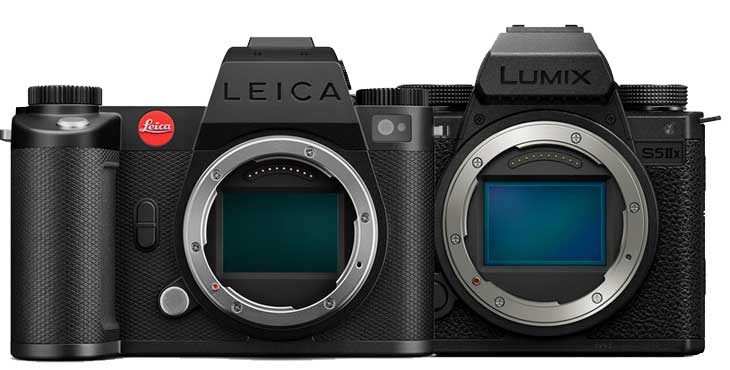
We are comparing the Leica SL3-S camera side by side with the Panasonic S5 IIX. Before we begin, I must tell you that there is a significant price difference between them. Starting with the design part. Next, we will move to the photography part, where we will compare the major core specifications that build up a camera’s character map. This will help photographers decide which camera to buy. In the final part of the comparison, in the third table, we have the video core specifications compared against each other.
Here you can purchase online B&H Store | Adorama | Amazon.com |
Get Panasonic S IIX DEAL at Amazon.com
1. Design Comparison
| Feature |
Leica SL3-S |
Panasonic S5IIx |
| Lens Mount |
L-Mount |
L-Mount |
| Build Material |
Aluminum, Magnesium Alloy |
Magnesium Alloy |
| Dimensions (W x H x D) |
Not specified |
5.29 x 4.03 x 3.55″ (13.44 x 10.24 x 9.02 cm) |
| Weight |
4.72 lb (2139 g) with battery |
1.64 lb (744 g) with recording media |
| Monitor Display |
3.2″ Tilting Touchscreen LCD, 2,332,800 dots |
3″ Free-Angle Tilting Touchscreen LCD, 1,840,000 dots |
| Viewfinder |
Built-In Electronic OLED, 5,760,000 dots, Approx. 0.76x magnification |
Built-In Electronic OLED, 3,680,000 dots, Approx. 0.78x magnification |
| Eye Point |
21 mm |
21 mm |
| Weather Sealing |
Yes |
Yes |
| Wireless Connectivity |
2.4 GHz MIMO Wi-Fi, Bluetooth 5.0 |
2.4 / 5 GHz Wi-Fi 5, Bluetooth 5.0 |
| GPS |
Yes (via connected smartphone) |
No |
| Dual Card Slots |
1x CFexpress Type B, 1x SD (UHS-II) |
Dual SD (UHS-II) |
Conclusion: So, from the design part, it’s very clear that Leica excels with its design. The most visible thing is the red logo and tank-like design that promises a very well-built quality camera. Besides that, we have a superior resolution electronic viewfinder with 5.7 million dots and a higher-resolution display screen. But again, there are some limitations in the display. It is tiltable but cannot be used for filming yourself. So, for content creators, the Leica SL3-S is not made for you.
The biggest difference you can spot, apart from all this, is that the Panasonic S5IIx camera features an active cooling mechanism with a built-in fan inside the camera. That’s why the camera can handle heat, whereas the Leica SL3-S has no active onboard cooling mechanism.
Now let’s compare the photographic core specifications of both cameras.
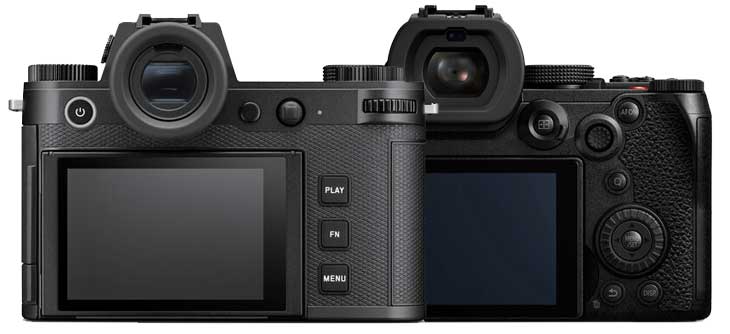
2. Photography Comparison
| Feature |
Leica SL3-S |
Panasonic S5IIx |
| Sensor Resolution |
24.6 MP effective (Full-Frame BSI CMOS) |
24.2 MP effective (Full-Frame CMOS) |
| ISO Range |
100 to 200,000 (Manual Mode) |
100 to 51,200 (Extended: 50 to 204,800) |
| Image Stabilization |
Sensor-Shift, 5-Axis |
Sensor-Shift, 5-Axis |
| Shutter Speed |
Mechanical: 1/8000 to 30 sec, Electronic: 1/16000 to 60 sec |
Mechanical: 1/8000 to 60 sec, Electronic: 1/8000 to 60 sec |
| Continuous Shooting |
Up to 30 fps [Latger Buffer] |
Up to 30 fps for 200 frames (JPEG/RAW) |
| Autofocus Points |
779 (Phase Detection and Contrast Detection) |
779 (Phase Detection and Contrast Detection) |
| Metering Modes |
Center-Weighted, Highlight Weighted, Multi-Zone, Spot |
Center-Weighted, Highlight Weighted, Multiple, Spot |
| Aspect Ratios |
3:2, 16:9, 17:9 |
1:1, 2:1, 3:2, 4:3, 16:9, 65:24 |
| Image Formats |
DNG, JPEG |
JPEG, RAW |
| Bit Depth |
14-Bit |
14-Bit |
| White Balance |
Auto, Cloudy, Color Temp, Daylight, Flash, Fluorescent (Cool/Warm), Manual, Shade, Tungsten |
AWB, Cloudy, Color Temp, Daylight, Flash, Incandescent, Shade, Custom (4 presets) |
Conclusion: In our table, we can see that there is a kind of negligible difference between these two. But if you consider the Leica body, the superior electronic viewfinder, the higher-resolution display screen, and budget doesn’t matter to you, then for sure, the Leica SL3-S is a great camera between the two. However, if you love to save $2,000, then the S5IIx is the best.
The alternatives of the Leica SL3-S camera
The best alternatives to the Leica SL3-S camera in this price range are the Nikon Z8 camera and the Canon R5. These are some of the best cameras available. Specification-wise, these are far better than the Leica SL3-S, and you have to pay almost a similar or a bit less price compared to the two.
3. Video Comparison
| Feature |
Leica SL3-S |
Panasonic S5IIx |
| Max Resolution |
UHD 6K (5888 x 3312) at 23.98/25/29.97 fps |
5.9K (5952 x 3968) at 23.98/24.00/25/29.97 fps |
| Video Formats |
H.264/H.265 Long GOP, MP4 (4:2:0 8/10-Bit), ProRes 4:2:2 |
H.264/H.265, MOV/MP4, ProRes 4:2:2/4:2:0 8/10-Bit |
| External Recording |
4:2:2 12-Bit via HDMI |
4:2:212-Bit via HDMI |
| Frame Rates |
Up to UHD 4K (3840 x 2160) at 59.94 fps |
Up to UHD 4K (3840 x 2160) at 59.94 fps |
| Slow Motion |
Slow Motion Only |
Yes |
| Gamma Curve |
Rec709, Rec2020 |
Panasonic V-Gamut, V-Log |
| Built-In Microphone |
Stereo |
Stereo |
| Audio Formats |
AAC, LPCM |
MOV: LPCM 24-Bit, MP4: AAC 16-Bit |
| Recording Limit |
No |
No |
| IP Streaming |
No |
RTP, RTSP (up to 4K at 25 Mb/s) |
| Bitrate |
Not specified |
Up to 800 Mbps |
| Heat Management |
Not specified |
Active Cooling |
| Autofocus in Video |
Phase Detection |
Phase Detection with AI Tracking |
| HDMI Port |
Full-Size HDMI |
Full-Size HDMI 2.1 |
| Timecode Support |
No |
Yes |
| Vertical Video Support |
Yes |
Yes |
Conclusion: Both cameras offer 6k at 30fps, 4k 30FPS uncropped and 4k60fps with crop [1.5x]. Again, in the video core specification part, you can see there is very little difference to spot. Other than that, I prefer the Panasonic S5 series camera’s V-Log. At the same time, we also have an active cooling mechanism that prevents it from overheating. So, more or less, for video core specification-wise, the Panasonic S5IIx camera is more recommended.
Also see – Sony FX30 vs Panasonic S5 IIX
By admin, on November 18th, 2024
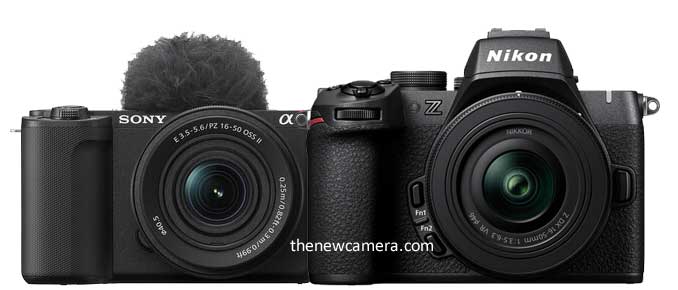
Let’s Compare the Sony ZV-E10 II and the Nikon Z50 II. The big question is, which one is better for your own personal requirements and your budget too? So, we are going to compare the major differences between the two, and you have to keep your requirements in mind. Every time we compare the major specs of the cameras, here we are also analyzing that particular spec in our conclusion and verdict part. Jump in and find out the best camera for you!
Nikon Z50 II vs Canon R10 | Nikon Z50 II vs Sony A6700
Design and Build
| Feature |
Nikon Z50 II |
Sony ZV-E10 II |
| Lens Mount |
Nikon Z |
Sony E |
| Body Material |
Magnesium Alloy |
Polycarbonate with Metal Components |
| Weight (With Battery) |
Approx. 450 g |
377 g |
| Dimensions (W x H x D) |
126.5 x 93.5 x 60 mm |
114.8 x 67.5 x 54.2 mm |
| Monitor Display |
3.2″ 1.04M-Dot Tilting Touchscreen LCD |
3.0″ 1.03M-Dot Articulating Touchscreen LCD |
| Viewfinder |
0.39″ OLED, 2.36M-Dot, 100% coverage |
No Viewfinder |
| Weather-Sealing |
Yes |
No |
| Built-In ND Filter |
No |
No |
| Hot Shoe Mount |
Yes |
Yes (Multi-Interface Shoe for Accessories) |
Design – Compact Creator vs Rugged Explore
These two cameras are completely different specifically design-wise. The Sony ZV-E10 Mark II camera does have a small hand grip for shooting occasionally, but as we know since it belongs to the SONY ZV Series has been designed for content creation and cinematography. It has an ultra-compact body with fewer controls. The camera also doesn’t have any weather sealing over it neither the EVF.
The Nikon Z50 Mark II HYBRID camera has an electronic viewfinder with 1000 nits brightness. It also has a very deep and redesigned hand grip, even better than its predecessor. At the same time, the body is weather-sealed, so you can shoot in uncontrolled light environments without any issues.
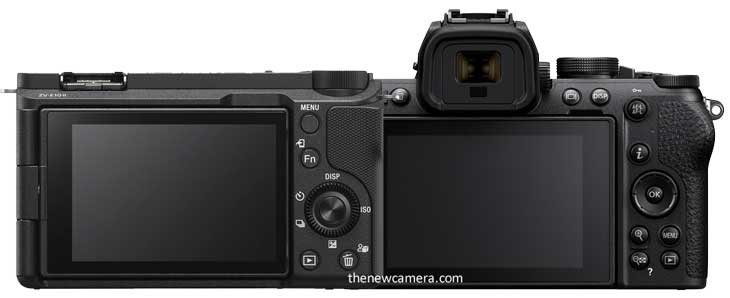
Best Camera as per Design Conclusion / Verdict
For portability, flexibility, and easier controls, the Sony ZV-E10 II leads. Again, for durability, extensive manual controls, and outdoor adventure, it is recommended to use the Nikon Z50 II camera.
Imaging Capabilities
| Feature |
Nikon Z50 II |
Sony ZV-E10 II |
| Sensor Type and Size |
APS-C CMOS, 23.5 x 15.7 mm |
APS-C CMOS, 23.3 x 15.5 mm |
| Resolution |
20.9 MP |
26 MP |
| ISO Sensitivity (Photo) |
100-51,200 (Expandable to 204,800) |
100-32,000 (Expandable to 50-102,400) |
| Continuous Shooting Speed |
11 fps 200 RAW/ 15 fps / 30 Fps Jpeg |
Up to 11 fps for 59 RAW / 1000 JPEG Frames |
| Autofocus Points (Photo) |
209 Phase-Detection Points |
759 Phase-Detection Points |
| Low-Light AF Sensitivity |
-9 EV |
-3 EV |
| Image Stabilization |
VR for Video only |
Digital + GYRO (Video Only) |
| Aspect Ratios Available |
3:2, 16:9 |
3:2, 16:9 |
| Image File Formats |
JPEG, NEF (RAW) |
JPEG, HEIF, Raw |
High Resolution vs Low Light Sensitivity
As we know, the Sony ZV-E10 II camera features a 26-megapixel CMOS sensor, while the Nikon Z50 II has a 20.9-megapixel sensor. Due to the resolution difference, the Sony ZV-E10 II camera captures more detail at the base ISO range starting from ISO 100-400, and it’s more recommended for landscape photography, portraits, and product shots where one wants to harness the maximum amount of detail possible from a camera.
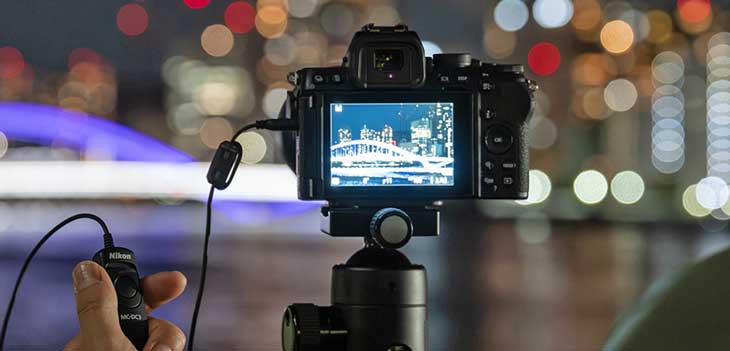
On the other hand, we have the Nikon Z50 II camera with a 20.9-megapixel sensor. Due to the lower resolution, we have large photodiodes inside this camera, which enables more incoming light to be absorbed, resulting in cleaner images at higher ISOs. For example, if you are shooting at ISO 1600 or 3200, the Z50 II camera will provide you with cleaner images compared to he compatitor.
Sensor Image Quality – Conclusion / Verdict
When shooting in uncontrolled light environments, it is highly recommended that you get the Nikon Z50 II camera, specifically when you are shooting wildlife where your subject can be at any place or time, then it’s recommended to have cameras like Z50 II that can capture better details or images at higher ISO ranges.
Autofocus: AI Precision vs Autofocus Consistency
Sony ZV-E10 II camera features 759 phase-detection autofocus points. Not only does the number of autofocus points matter, but the autofocus algorithm of the Sony ZV-E10 II camera is powered by an advanced AI AF algorithm, so it enhances the overall autofocus experience 2x better than what it was in the Sony A6400 camera.
And Nikon Z50 Mark II also arrives with an upgraded autofocus system. As per Nikon’s press text, the Z50 Mark II camera uses the same autofocus algorithm that we have seen in the Nikon Z8 camera. Having said that, it’s a major improvement in Nikon APS-C lineup, and without a doubt, you can feel it. For example, even at 30 frames per second when you are using Nikon Z50 II at C30 mode, the camera does autofocus and auto-exposure calculation in every frame. That is a clear indication of how fast the Z50 Mark II autofocus calculation has now become.
The good thing about Nikon Z50 Mark II is, apart from improved autofocus modes, the camera does autofocus sensitivity up to -9 EV, whereas in Sony it’s limited to -3 to -4 EV depending upon the type of lenses you are using in both the cameras.
30 FPS Continuous shooting speed, the Nikon Z50 II camera features continuous shooting upto 30 FPS as well as Pre-Brust modes of 0.35ses, .05 Ses, and 1.0 Sec that captures a MAX of 30 Jpegs before you hit the shutter, one of the only cameras that offer pre-burst mode in this price segment.
Best AutoFocus – Conclusion / Verdict
Now, even though the Z50 II autofocus is much improved, for action-packed VIDEOS, it is highly recommended to use the Sony ZV-E10 Mark II camera 😉 . But for shooting action-packed images at higher frame rates, Z50 is the best option where you have multiple options like shooting with a mechanical shutter or electronic, at the very same time, the camera does autofocus and auto-exposure calculation all the way, even at 30 fps. That’s the Nikon Z50 II recommended for shooting action-packed images when we have these two options in front.
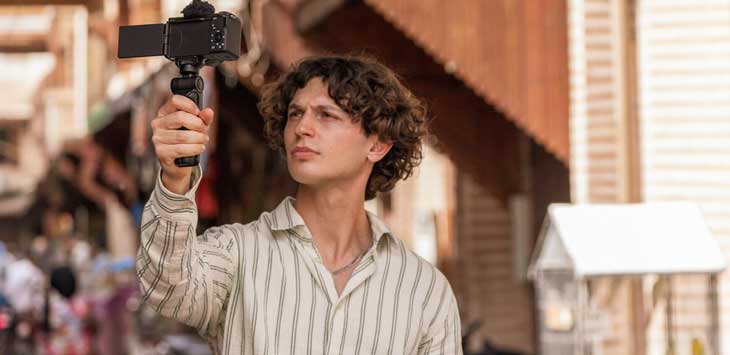
Electronic Stabilization vs Gyro
None of the cameras has Sensor-Shift IS [No Mechnical], The Sony ZV-E10 II camera uses GYRO which also includes active image stabilization. The Active IS works flawlessly but needs wide lenses to crop and apply the steb. If you have that much wider better to use GYRO. Nikon Z50 Mark II camera uses electronic stabilization in video mode [E-VR], which is of course not as good as we have in the Sony ZV-E10 II, but yeah, it is effective to some extent.
Best Camera for Handheld Shooting – Conclusion / Verdict
Since none of them have any kind of mechanical stabilization inside them, and if you talk about electronic image stabilization, then Sony excels while using the active mode as well as an option to use gyro-based image stabilization.
Video Capabilities
| Feature |
Nikon Z50 II |
Sony ZV-E10 II |
| Internal Recording Modes |
H.264/H.265 8/10-Bit |
XAVC HS/S 4:2:2 10-Bit, XAVC S 8-Bit, XAVC S-I 10-Bit |
Max 4K Res.
|
UHD 4K 60p 1.5X Crop |
UHD 4K 60p 1.04X Crop |
| High-Speed Recording |
1920 x 1080 up to 120 fps |
1080p up to 240 fps |
| Recording Limit |
Approx. 121 mins |
No recording limit |
| Gamma Profiles |
N Log |
S-Cinetone, S-Log3 |
Luts
|
RED-Luts |
Picture Profiles |
| Built-In Microphone |
Mono |
Stereo |
| Audio Inputs and Outputs |
Microphone and Headphone |
Microphone input, Headphone output |
| Focus Points (Video) |
209 Phase-Detection Points |
495 Phase-Detection Points |
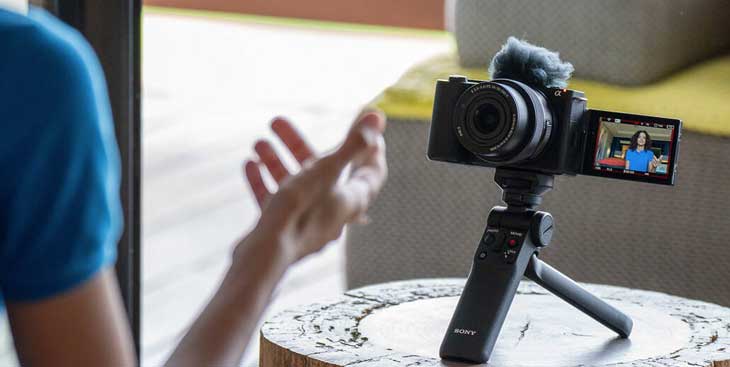
Color Science: Grading Playground vs. Ready-to-Use Output
Sony ZV-E10 II camera is built for cinematic video and content creation purposes. It supports 4K video recording up to 60 frames per second with a negligible crop of 1.03x. At the same time, you can record your videos in 10-bit 4:2:2 internally. It also supports professional-grade S-Log3 and S-Cinetone, which professionals generally prefer to use.
The Sony ZV-E10 II camera also features a gyro-based image stabilization system backed by Active Mode, so depending on the type of lens you have, you can utilize any of these image stabilization methods.
Yes, we do have Product Showcase Mode and Active Framing, ideal for content creators shooting solo content. Additionally, the battery life and ultra-compact body make it highly portable.

Nikon Z50 II camera features 4K 60p recording with a 1.5x crop, which may or may not suit many professionals out there. However, the good news is that the Nikon Z50 II features natural color science, inspired by RED camera makers. The RED-like color science is now available in the Z50 II camera. Additionally, the camera also supports waveform function, which professionals will love.
If you make talking-head videos while sitting in your room, you can use the newly developed Product Review Mode or Product Showcase Mode of the Nikon camera. However, the image stabilization is not as effective as that of Sony’s.
If you’re a professional cinematographer, short filmmaker, or story trailer, you’ll appreciate the RED-like color science present in the Z50 II. Despite the crop in 4K 60p, if you’re okay with it, you’ll benefit from waveform support, which is highly essential for professional storytelling.
The Sony ZV-E10 II camera, designed for video creation, includes all the bells and whistles you’d wish for in a professional video camera.
Power and Connectivity
| Feature |
Nikon Z50 II |
Sony ZV-E10 II |
| Battery Type |
EN-EL25a, Approx. 320 Shots |
NP-FZ100, Approx. 610 Shots |
| USB-C for Power/Charging |
Yes |
Yes |
| Media/Memory Card Slot |
Single SD Slot (UHS-II) |
Single SD Slot (UHS-II) |
| Wireless |
Wi-Fi, Bluetooth |
Wi-Fi (2.4/5 GHz), Bluetooth 4.2 |
| Mobile App Compatibility |
SnapBridge |
Creators’ App (Android & iOS) |
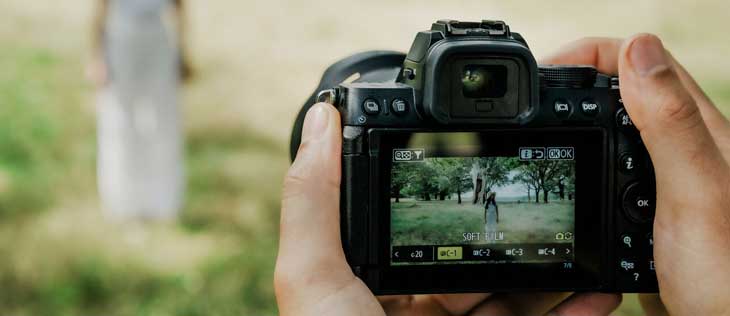
Nikon Z50 Mark II: Weather-Sealed BODY and Low-Light Sensor
In conclusion, the Sony ZV-E10 II camera and the Nikon Z50 Mark 2 camera are made for different types of users. If you look carefully, without a doubt, the Nikon Z50 Mark 2 camera has been made with a deep hand grip, EVF and a rugged body. The camera also features excellent low-light performance with its 20.9 MP sensor and, without the option of an optical low-pass filter, it captures decent images at base ISO. This makes it an ideal camera for wildlife photography, event photography, and even travel photography where you have a completely uncontrolled set of environments and lights.
Sony ZV-E10 II: Best for HANDHELD Content Creators
The Sony ZV-E10 II camera is a content creator’s powerhouse that offers 4K 60 FPS recording, which is almost uncropped since it has only a 1.03x crop, which is unnoticeable. You can record 10-bit videos internally, powered by S-Log3 and S-Cinetone. One of the best things about the Sony camera is that you are getting active image stabilization backed by gyro-based stabilization, ideal for those who love to shoot their content on the go. It will provide completely stable, high-quality footage. Additional features include product showcase mode, active framing, and a three-capsule microphone to record high-quality audio directly in the camera. More or less, it is highly recommended for content creators.
Sony ZV-E10 II: For Photography?
Yes, you can occasionally use the ZV-E10 II camera for photography purposes to get a resolution advantage, but it is highly recommended that you use this camera with proper lighting conditions to extract the maximum amount of detail possible.
Nikon Z50 Mark II: Cinematographers and StoryTellers
The Nikon Z50 Mark II camera does have some exceptional advantages in video recording modes that should not be overlooked. It captures clean and noise-free videos at higher ISO levels and has been inspired by RED cinema profiles. Moreover, it also features waveform capability with a weather-sealed body. So if you are a short film storyteller or beginner cinematographer, you should consider these factors before getting your first camera for professional cinematography purposes.
Sony ZV-E10 II from B&H Store | Amazon.com
Sony ZV-E10 II Recommended for:
- Casual Clicks
- Wedding Video
- Vlogging / YouTube Content Creation
- Solo Content Creation (Active Framing & Product Showcase Mode)
- Cinematic SOLO Videography (with S-Log3 & S-Cinetone)
- Casual Travel Videography
- Compact, On-the-Go Shooting
Get a Nikon Z50 Mark II camera from the B&H Store | Amazon.com
Nikon Z50 II Recommended for:
- Low-Light Photography
- Wildlife Photography
- Wedding Photography
- Event Photography (due to clean high ISO performance)
- Documentary Videography
- Cinematic Filmmaking (low light, RED-inspired color science)
- Rugged Outdoor Photography (weather-sealed body)
- Travel Photography in Challenging Environments
- High ISO Videography
- Professional Video Shoots (Waveform & RED LUTs)
Support us – Use or affiliate link Amazon.com | B&H Store for the next purchase u make – it helps us 🙂
Follow us on our social pages FACEBOOK | TWITTER | INSTAGRAM to get live Camera News +
By admin, on November 9th, 2024
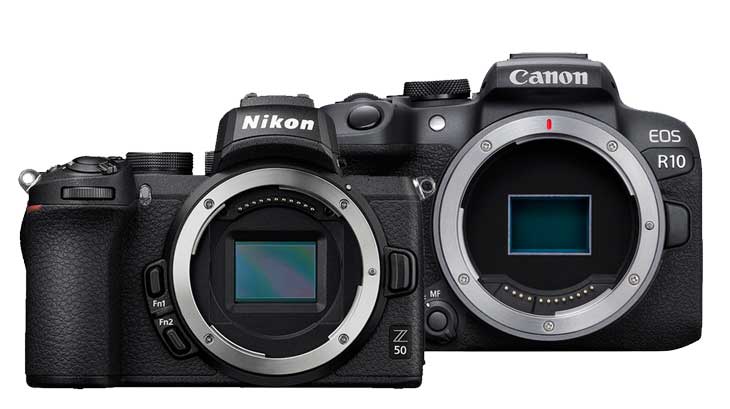
Let us compare the Nikon Z50 II with the Canon R10 camera. Let’s explore the main differences between these two cameras and find out which one is the best for photographers and which one is best for shooting videos. In the comparison table below, we have highlighted the differences in design, and we have created two separate tables dedicated to photography and videography features. So let’s find out the best camera between these two for your specific needs and budget.
1. Design Comparison
| Feature |
Nikon Z50 II |
Canon R10 |
| Body Dimensions |
5 x 3.8 x 2.6″ / 127 x 96.8 x 66.5 mm |
4.8 x 3.5 x 3.3″ / 122.5 x 87.8 x 83.4 mm |
| Weight |
495 g (Body Only) |
382.2 g (Body Only) |
| Lens Mount |
Nikon Z |
Canon RF |
| Display |
3.2″ Tilting Touchscreen LCD, 1,040,000 Dot |
3.0″ Free-Angle Tilting Touchscreen LCD, 1,040,000 Dot |
| EVF Type |
Built-In Electronic (OLED), 0.39″, 2,360,000 Dot – 1000 NITS Brightness |
Built-In Electronic (OLED), 2,360,000 Dot |
| Battery Type |
EN-EL25a or EN-EL25, approx. 230 shots |
LP-E17, approx. 430 shots |
| Ports |
USB-C Data & Power, Micro-HDMI, Mic & Headphone Jacks |
USB-C, Micro-HDMI, Mic Jack |
| Available Lenses |
Nikon Z DX and FX lenses |
Canon RF-S and RF lenses |
2. Photographic Feature Comparison
| Feature |
Nikon Z50 II |
Canon R10 |
Sensor Type
|
BSI CMOS |
FSI CMOS |
| Sensor Size |
23.5 x 15.7 mm (APS-C) |
22.3 x 14.9 mm (APS-C) |
| Effective Resolution |
20.9 Megapixel |
24.2 Megapixel |
| ISO Range (Photo) |
100 to 51,200 (Extended: 100 to 204,800) |
100 to 32,000 (Extended: 100 to 51,200) |
| Shutter Type |
Mechanical Focal Plane, Electronic Rolling |
Mechanical, Electronic Rolling |
| Shutter Speed (Mechanical) |
1/4000 to 900 sec |
1/4000 to 30 sec |
| Bulb Mode |
Yes |
Yes |
| Continuous Shooting (Mech) |
Up to 11 fps at 20.9 MP |
Up to 15 fps at 24.2 MP |
| Continuous Shooting (Elec) |
Up to 30 fps at 20.9 MP (JPEG) |
Up to 23 fps at 24.2 MP |
Pre-Capture Mode
|
1 Sec |
0.5 Sec |
| Autofocus Points |
231 (Phase & Contrast Detection) |
651 (Phase Detection Zones) |
| AF Sensitivity |
-9 to +19 EV |
-4 to +20 EV |
| AF Modes |
Continuous-Servo AF, Full-Time AF, Manual, Single-Servo AF |
Continuous-Servo AF, Manual, Single-Servo AF |
Weather sealed
|
Yes |
No |
Battery Life
|
250 Shots |
450 Shots |
3. Video Comparison
| Feature |
Nikon Z50 II |
Canon R10 |
| Sensor Type |
BSI CMOS |
FSI CMOS |
| Video Resolution & Frame Rates |
UHD 4K (30 fps) Uncropped |
UHD 4K (30 fps) Uncropped |
4k 60 FPS
|
1.5X Cropped |
1.5x Cropped |
Full HD Max Frame rate
|
120 FPS |
100 FPS |
Product showcase mode
|
Yes |
No |
| Video Stabilization |
Digital (Video Only) |
Digital (Video Only) |
| Internal Recording Codec |
H.264/H.265 (8/10-Bit) |
H.264 MP4 4:2:0 8-Bit, H.265 MP4 4:2:2 10-Bit |
| External Recording Codec |
HDMI 4K |
HDMI 1080p |
| HDR/LOG Support |
HDR-HLG, Nikon N-Log |
HDR-PQ |
Support RAW Video
|
Yes, N-Log available |
No, C-Log isn’t there |
| Recording Limit |
Up to 125 minutes |
Upto 120 Mins |
| Audio Recording |
Stereo, 24-Bit 48 kHz LPCM or 16-Bit AAC |
Stereo, 2-Channel AAC |
Conclusion Verdict
The Nikon Z50 II camera now has much-improved autofocus and also a low-light sensor, which helps to extract the maximum amount of detail possible in uncontrolled lighting environments or in any outdoor location. For wedding and event photography, we recommend you to go with Nikon Z50 II
Now, for sports and wildlife, it depends on which camera you like to buy since both are very capable. But again, due to the presence of a BSI CMOS sensor, the Z50 Mark II camera will perform better in uncontrolled lighting environments, specifically when you are using this camera for wildlife or bird photography. However, for sports events, you can take the Canon R10 with you when there is no big issue with light, as sports events generally happen during daylight. So, you may utilize the R10, and also, in sports events, you may require more reliable autofocus tracking, which is present in the Canon R10 alongside its slightly faster 15 fps mechanical shutter.
For day-to-day usage and street photography, I am going to recommend the Nikon Z50 Mark II camera. Due to the nature of its sensor and construction, the camera is able to capture clear shots and also has high low-light autofocus sensitivity compared to the R10. So more or less, for uncontrolled lighting environments of any type, the Nikon Z50 Mark II is more recommended. 165
Get a Nikon Z50 Mark II camera from the B&H Store | Amazon.com
Canon R10 – Camera body $879 [B&H Store] [Amazon.com] |
| Type of Photography/Video |
Recommended Camera |
| Wedding and Event Photography |
Nikon Z50 II
Due to its improved autofocus, low-light sensor, and availability of third-large amount party lenses , we recommend you to go with Nikon Z50 II |
| Wildlife and Bird Photography |
Nikon Z50 II
The BSI CMOS sensor in the Z50 II performs well in low-light and uncontrolled lighting, which is often required in wildlife photography. + You get AF sensitivity down to – 9 FV and upscaled 3d AI AF tracking. |
| Sports Photography (Daylight Events) |
Canon R10
Reliable autofocus tracking and slightly faster 15 fps mechanical shutter make the R10 a strong choice for sports events in daylight conditions. |
| Everyday Use and Street Photography |
Nikon Z50 II
Excellent low-light autofocus sensitivity and sensor design allow the Z50 II to capture clear shots in diverse lighting, making it versatile for daily use. |
| General Video Needs |
Canon R10 (for daylight, faster autofocus)
OR Nikon Z50 II (for low-light video) |
Nikon Z50 II Image Quality Test
Nikon Z30 / Zfc Image samples have been taken here since Nikon Z50 II and Zfc, both of them share the same sensor, so image quality is expected to remain exactly same as of the Nikon Z50 Mark II. Image credit dpreview.com
In the Image below we have compared the Nikon Z30 vs Canon R10 Images at ISO 25600, in RAW mode, as you can see the details are much preserved in Nikon Z50 II file
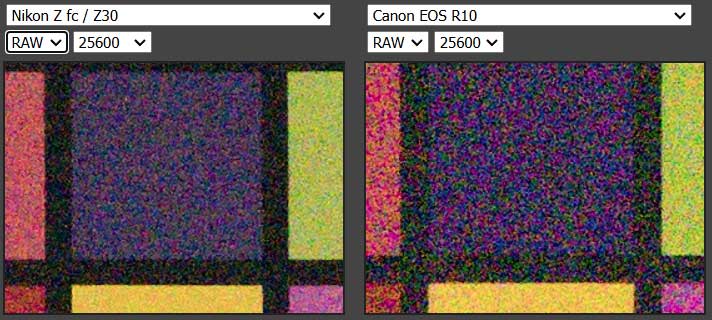
Next comparison Even in the JPEG comparison below you can see that Nikon is preserving more details compared to the Canon R10 FSI CMOS sensor.
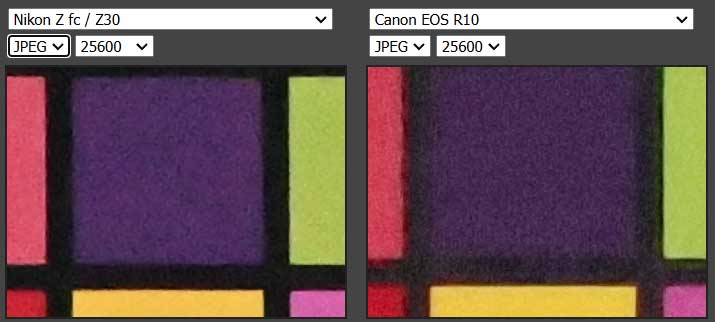
During the base ISO test we can see the letters in the Nikon Z50 II are more clearly visible than those of the Canon R10, despite having higher resolution Canon isn’t able to extract the amount of details they should at the base ISO range
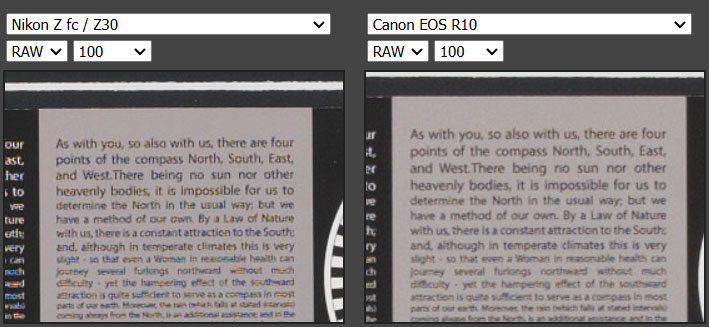
In the JPEG Mode, the performance of the Canon R10 Camera is much improved which may be due to JPEG filters the Nikon Z30 sample at base ISO losing a bit of details which was visible in the RAW Mode.
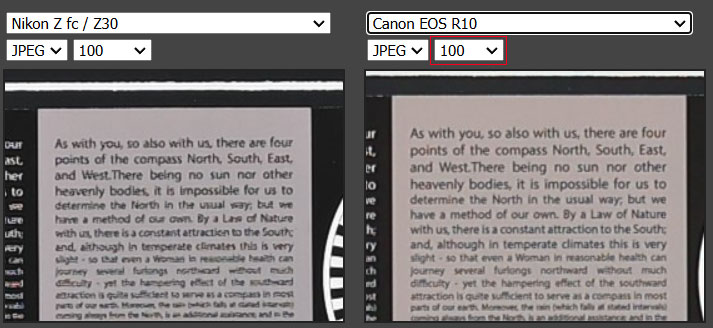
Verdict / Conclusion Image Quality
In terms of image quality, the Nikon Z50 II performs better than the Canon R10 at higher ISO settings, particularly when shooting in RAW mode. The Nikon Z50 II (or Z30) tends to capture more details at higher ISOs due to its 20MP sensor and lack of a low-pass filter, which helps to maintain fine textures.
However, at base ISO, when shooting in JPEG, the Canon R10 may show slightly more detail due to its higher 24MP resolution. But if you’re shooting in RAW at base ISO, the Nikon cameras can still provide a slightly clearer picture due to the low-pass-less design, which can enhance sharpness. Overall, for detail preservation, the Nikon Z50 II’s 20MP sensor has a slight edge, especially for those who prioritize high ISO performance and RAW shooting.
Support us – Use or affiliate link Amazon.com | B&H Store for the next purchase u make – it helps us
Follow us on our social pages FACEBOOK | TWITTER | INSTAGRAM to get live Camera News +
By admin, on October 15th, 2024
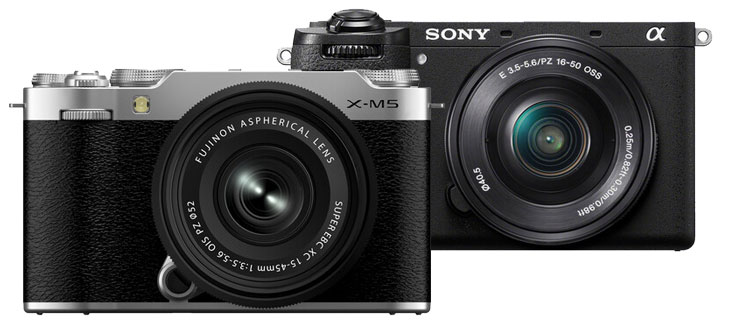
Let’s compare the Fuji X-M5 versus the Sony A6700 camera. We have compared the photographic & videography features in a separate table, so you can easily understand which camera is best for you.
If you are a photographer, which camera should you buy? Again, if you are a content creator, videographer, or wedding filmmaker, which camera should you choose?
Take a look at the specification comparison table below, where we have highlighted the major differences between the two cameras. They also have some similarities, but the good thing is that the Fuji X-M5 camera is able not only to compete but also to uplift the competition bar by upscaling the core specifications.
Fuji X-M5 vs Sony A6700 – 15 Major Differences for Photographers
| Feature |
Fuji X-M5 |
Sony A6700 |
| Sensor Resolution |
26.1 MP APS-C CMOS |
26 MP APS-C Exmor R BSI CMOS |
| Image Processor |
X-Processor 5 |
BIONZ XR |
| ISO Range (Photography) |
160 to 12,800 (Extended: 80 to 51,200) |
100 to 32,000 (Extended: 50 to 102,400) |
| Autofocus Points (Photo) |
425 Phase Detection Points |
759 Phase Detection Points |
| Autofocus Sensitivity |
-7 EV |
-3 EV |
| Continuous Shooting |
Up to 30 fps (Electronic, cropped) |
Up to 11 fps (Mechanical & Electronic) |
| Viewfinder |
No Viewfinder |
2.36M-dot OLED Viewfinder |
| Shutter Speed (Mechanical) |
1/4000 to 30 seconds |
1/8000 to 30 seconds |
| Mechanical Shutter |
Yes |
Yes |
| Image Stabilization |
NA |
5-Axis In-Body Image Stabilization (IBIS) |
| Sensor Type |
Standard CMOS |
Backside Illuminated (BSI) CMOS |
| Weather Sealing |
Yes (Dust & Water Resistant) |
Yes (Dust & Moisture Resistant) |
| Battery Life (Stills) |
Approx. 460 shots |
Approx. 570 shots |
| Weight |
355g (Body Only) |
493g (Body Only) |
| Memory Card Slot |
Single SD UHS-I Slot |
Single SD UHS-II Slot + CFexpress Type A |
Quick Analysis of Specification Differences between the two
The core specifications of the Fuji X-M5 camera look very impressive when compared with the Sony A6700 camera.
If you are a photographer, then of course you will miss the sensor-shift image stabilization in the Fuji X-M5, which is present in the Sony A6700.
Having image stabilization in your camera is really important if you shoot images in low-light environments. The image sensor compensates for hand movements even when you are using a slow shutter speed, resulting in neat and clean images.
Another feature that will help the Sony A6700 camera is the high ISO range, which is expandable from 50 up to 102400.
But wait, we still have some significant differences that might affect your choice. Another big difference for photographers to consider is the continuous shooting speed. If you don’t want any rolling shutter effect visible in your images, you have to use the mechanical shutter, as the electronic shutter can cause rolling shutter effects, especially with non-stacked sensors.
Autofocus Sensitivity and Tracking
Finally, let’s talk about the autofocusing systems of both cameras. We have seen the autofocus sensitivity difference between the two. If you compare them, the Fuji X-M5 camera looks very impressive with -7 EV autofocus sensitivity against the A6700 camera, which has -3 EV autofocus sensitivity. But this autofocus sensitivity only works once to acquire the autofocus point in extremely low-light situations.
Now, let’s consider a situation where quick moment-to-moment focus is needed. In this case, the Fuji X-M5 may focus more quickly compared to the A6700, due to its AF sensitivity. However, when we talk about autofocus tracking performance, due to the higher number of phase-detect autofocus points present in the Sony sensor—approximately 759 compared to Fuji’s 425—the tracking performance of the Sony A6700 sensor will be better than the X-M5.
So, we have two differences here. First, autofocus acquisition is better in the Fuji, but at the same time, the autofocus tracking performance is better in the Sony. Generally, most autofocus modes rely on the tracking performance of the camera, not on the acquisition part, so I would give a slight advantage to Sony in terms of tracking performance.
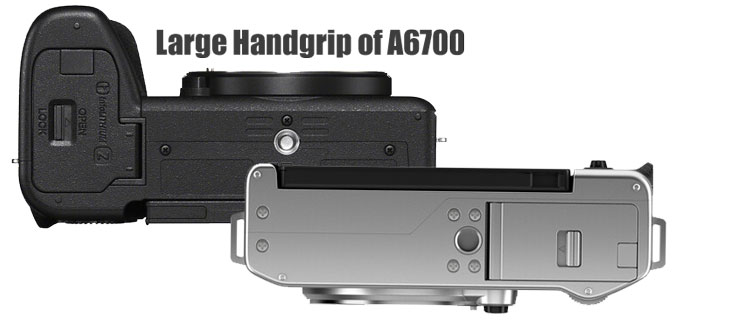
Design and Battery Life
Finally, let’s talk about the design part of both cameras. The Sony A6700 camera hand grip is deeper and much better compared to the Fuji X-M5. At the same time, we have a dedicated OLED viewfinder in the body of the Sony A6700 camera, which helps photographers who are used to using optical viewfinders from DSLRs. So, more or less, if we talk about ease of use and digital body design, the A6700 camera is more user-friendly.
At the same time, if we talk about battery backup, the Sony offers a bigger battery, resulting in more shots per charge—approximately 570+, whereas in Fuji, you are getting around 460. So yes, we do have some differences.
Conclusion: The best camera for photographer
should you go with the Fuji X-M5 or the Sony A6700? We get some extra features from inside to out with the Sony A6700 camera. Have a look:
The positive features of the Sony A6700 include the presence of a sensor-shift image stabilization system, which helps capture clear images in low-light environments. At the same time, the wide ISO range, starting from 50, is completely absent in the Fuji X-M5. Additionally, the A6700 offers a bigger battery life, which makes it a better option for professional photographers.
Not only that, but we also have a very large range of E-mount lenses from Sigma, Tamron, and many other brands. Although the Fuji X-mount is also open, it is not as big or broad as the E-mount at the moment, even though there are many options in X-mount.
Compared to the X-M5, we do see some advantages like autofocus sensitivity and continuous shooting speed. So, if you really want a camera with fast continuous shooting speed and don’t care much about the ISO range, image stabilization system, battery grip, or battery life, then the X-M5 might be a good option. However, for a photographer, we highly recommend the Sony A6700.
Fuji X-M5 vs Sony A6700 – 15 Major Video-Related Differences
| Feature |
Fuji X-M5 |
Sony A6700 |
| MAX Video Resolution |
6.2K up to 30 fps |
4K up to 120 fps |
| Slow-Motion Video |
1080p at 240 fps |
4K at 120 fps, FHD at 240 fps |
| Video Codec |
H.264/H.265 (HEVC) |
H.264/H.265 (HEVC), XAVC S-I |
| Video Bitrate |
400 Mb/s |
600 Mb/s |
| Video Recording Limit |
50 minutes in 4K |
No Recording Limit |
| Log Profiles |
F-Log, F-Log 2 |
S-Log 3, S-Cinetone |
| Autofocus Points (Video) |
425 Phase Detection Points |
759 Phase Detection Points |
| Autofocus Features |
Face/Eye Detection |
Real-time Tracking, Eye AF for Video, AI framing |
| External Recording |
4:2:2 10-bit via HDMI |
4:2:2 10-bit via HDMI |
| Viewfinder for Video |
No EVF |
Yes, 2.36M-dot OLED Viewfinder |
| Display Type |
3-Way Tilting LCD |
Fully Articulating LCD |
| Video Stabilization |
Electronic |
5-Axis IBIS + Active Mode for Video + Gyro |
| Audio Inputs |
3.5mm Mic Jack, 3.5mm Headphone Jack |
3.5mm Mic Jack, 3.5mm Headphone Jack |
| Mobile Streaming |
No |
Yes (IP Streaming 4K) |
video core specifications
Let’s compare the video core specifications between the Fuji X-M5 and the Sony A6700 cameras.
We have an open gate option in the Fuji X-M5, which videographers will love, especially for professional filmmaking, allowing them to decide the format and ratio for an entire scene. It’s better to record in open gate. In addition, we have options like Full HD mode at 240 frames per second for capturing slow-motion videos.
However, if you compare the X-M5’s features against the Sony A6700, you will miss the higher-resolution open gate mode. But aside from that, the Sony A6700 offers 4K @ 120 frames per second and can also record Full HD videos at 240 frames per second. The bitrate is approximately 600 Mbps, which is better than the X-M5’s 400 Mbps, even though Fuji offers a 6.2K open gate recording option.
A higher bitrate means more color information, and this will definitely help Sony users a bit more. In addition, we have a dedicated AI chip in the Sony A6700, which enhances autofocus tracking performance in video mode, including AI-based auto framing.
The good news is that Fuji is also improving their autofocus modes in the new X-M5 camera. Similar to Sony, they have introduced a product feature mode in the X-M5, showing Fuji is slowly trying to compete with Sony’s features in the A6700 camera.
Aside from all these features, the Sony A6700 has a 2.36-million-dot electronic viewfinder, which may not directly help with filmmaking, but is still a useful feature. However, the biggest factor is the presence of a sensor-shift image stabilization system.
With sensor-shift image stabilization, we can use active mode in video on the Sony camera to achieve smooth and stable footage. Sony also offers a gyro-based image stabilization system, which can smooth out footage like a GoPro when processed with special software.
Conclusion – Best Camera for Video
When you compare all these features, the Sony A6700 looks more appealing. However, if you are a Filmmakers (Independent or Short Films) prefer the open-gate recording format, you can go with the Fuji X-M5. But if you’re asking which one is more usable and practical camera, for
- For Wedding Cinematographers
- For Traditional Videographers (Corporate, Documentaries):
- For Content Creators
The Sony A6700 is more usable, with its 4K 120 FPS mode, advanced autofocus tracking with a dedicated AI chip, and hybrid image stabilization, which is the better option. The Sony A6700 simply offers a more advanced set of features.
Final Recommendations:
- Fuji X-M5 is recommended for filmmakers who need open gate recording and prefer high-resolution control.
- Sony A6700 is a all-in-one all-rounder for content creators, wedding cinematographers, and traditional videographers, features advanced autofocus, 4K 120 FPS, and Excellent stabilization features.
Fuji X-M5 Price
Fujifilm X-M5 Body: £799 / €899- B&H Store
Fujifilm X-M5 + XC 15-45 Kit: £899 / €999 – B&H Store
Sony A6700 Price
Sony A6700 Body: $1398 B&H Store | Amazon.com
Sony A6700 with Kit Lens: $1498 – B&H Store and Amazon.com
Support us – Use or affiliate link Amazon.com | B&H Store for the next purchase u make – it helps us
|
KEEP THIS BLOG ALIVE - Support New Camera Buy Canon Lenses, Buy Music CD or Digital Camera at amazon it helps this site, and you do not pay anything extra, it is just a way to help support this site.

|


























